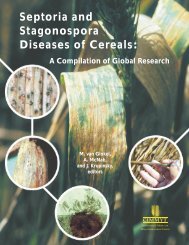Section 3 (Crop Management)
Section 3 (Crop Management)
Section 3 (Crop Management)
You also want an ePaper? Increase the reach of your titles
YUMPU automatically turns print PDFs into web optimized ePapers that Google loves.
Boonpradub and Kraokaw<br />
Cultivars<br />
Kernel yields in all twenty-one maize genotypes when grown under irrigated conditions were<br />
significantly different (Table 2). Pioneer 3012, Cargill 727 and Pacific 700 provided an average of 15 to<br />
26 % increase in kernel yields over NS 72 (check). This was probably due to greater kernels per ear as<br />
compared to other genotypes. Boonpradub and Senthong (2001) also evaluated the thirty-one maize<br />
genotypes including hybrid and open-pollinated varieties under different moisture regimes using a line<br />
source sprinkler irrigation system. They found that Pioneer 3012 showed significantly the highest kernel<br />
yield under well-watered condition.<br />
Planting time<br />
When maize grown under post-rice condition, planting time significantly showed different in kernel<br />
yield as shown in Table 3. Results found that mid-November to mid- December was found best for<br />
planting this crop in post-rice condition. There was probably due to maize obtaining better kernel number<br />
and kernel weight. To delay planting of maize thereafter, its yield was generally low. The reduction was<br />
24 and 36 % when grown in January and February, respectively. Yield loss due to delay planting was<br />
high temperature during flowering date (data not shown). Furthermore, ear number was not affected by<br />
planting time.<br />
Plant density<br />
The results as shown in Table 4 indicated that maize grown under plant density at 66,666 plants ha -1<br />
gave significantly 18% higher kernel yield than those at 53,333 plants ha -1 resulting in more ear number<br />
per ha. However, plant height and yield components; namely ear width, ear length and kernel weight,<br />
were not affected by plant density. Boonpradub et al. (1998) had been studied on maize grown after rice<br />
under different plant densities found that mean yield increased consistently with increase in plant density<br />
from 53,333 plants ha -1 to 80,000 plants ha -1<br />
Fertilization<br />
The nitrogen fertilizer was needed to be applied in order to increase maize yield when grown under<br />
post-rice condition as shown in Table 5. The kernel yield of maize with 187.5 kg N ha -1 application was<br />
not significantly superior to that of 125 kg N ha -1 . However, it was significantly different when compared<br />
with 62.5 kg ha -1 as a results of higher kernel number. A greater reduction in kernel number as affected by<br />
nitrogen stress was probably due to delayed silking resulting in an increase in the length of the anthesis -<br />
silking interval (ASI) as the results of nitrogen deficiencies (Girardin et al., 1987). The application of<br />
nitrogen fertilizer as a basal fertilizer followed by a top-dressing fertilizer at 1 month should be<br />
recommended. Similar result was also displayed when its trial was done under farmers’ fields (Table 6).<br />
The recommended N fertilizer showed higher kernel yield and better economic return as compared to<br />
farmers’ practices.<br />
Conclusion<br />
It can be concluded that maize has become a newly upland crop for growing under the post-rice<br />
condition in Thailand. This is probably due to its providing better income and profit for the farmers as<br />
compared to the second rice. In addition, it is helpful to reduce water consumption during dry season and<br />
break the population dynamic of pest. However, besides major on soil and environmental constraints, the<br />
suitable maize cultivars, appropriate cultural practices and more seed available also need to be further<br />
developed.<br />
- 310 -









